
Credit: Reese Zoellner, Armstrong Institute of Biblical Archaeology
The discovery of a minuscule golden pendant during archaeological work in Old Jerusalem’s Ophel, the area surrounding Temple Mount, has finally caught the attention of archaeologists, the Armstrong Institute of Biblical Archaeology reports.
The pendant-like item made of the naturally occurring electrum (a gold and silver alloy) is now hitting above its weight.
First discovered in 2012, the 4x4x2 millimeter basket-shaped item could have served as either a pendant or perhaps even an earring.
But for the next 11 years, it was basically ignored.
Then in 2023 archaeologists decided to take a closer look at the artifact and discovered several important facts about it.
First, they determined that it was made of a gold-silver alloy.
Secondly, after comparing it with other items discovered in the Middle East, they determined that it was made in Phoenicia, as it clearly resembled other known Phoenician artifacts.
Thirdly, it was determined with certainty that it was made in the 10th Century BCE, making it 3,000 years old. It not only became the oldest artifact made of gold ever discovered in Old Jerusalem, but it was also older than the comparative items discovered in Phoenicia.
It was at this point, that this seemingly insignificant artifact began hitting above its weight. Its Phoenician origin, combined with its age, meant it had been lost in Jerusalem during the reign of King Solomon.
It confirmed an interesting time in ancient Israel’s history when a close relationship developed between Phoenicia’s King Hiram and King David and his son, King Solomon.
Now Hiram king of Tyre sent his servants to Solomon when he heard that they had anointed him king in place of his father, for Hiram had always been a friend of David. (1 Kings 5:1 NASV)
It was so close, that King Hiram actually helped Solomon construct both the Jewish Temple (2 Chronicles 2:7, 15) and a palace in Jerusalem (2 Samuel 5:11).
According to the Biblical record, in addition to providing cedar wood, King Hiram sent craftsmen, carpenters, metalworkers, and stonemasons, to construct Solomon’s royal quarters in what today is referred to as the Ophel, where this artifact was discovered.
This discovery becomes even more intriguing because, as Brent Nagtegall points out in his article for Armstrong, the Bible even provides a description of one of the men that King Hiram sent to Jerusalem to help.
“He is trained to work in gold, silver, bronze, iron, stone, and wood, and in purple, blue, and crimson fabrics and fine linen, and to do all sorts of engraving and execute any design that may be assigned him, with your craftsmen, the craftsmen of my lord, David your father,” said King Hiram in 2 Chronicles 2:14.
This particular Phoenician man, trained in both gold and silver, sounds like just the kind of guy who could have lost a gold pendant while working in Jerusalem.
Of course, he was just one of many Phoenicians working in the city at the time.
But this small pendant helps confirm the Biblical record that the Phoenicians were working in Jerusalem during King Solomon’s reign.
